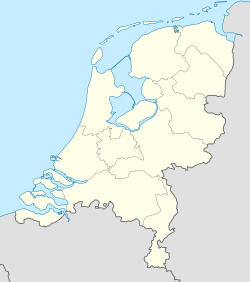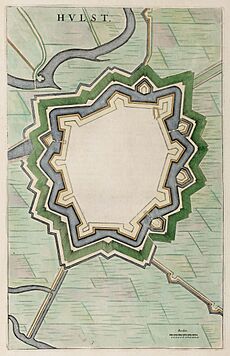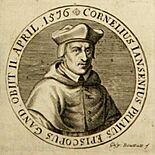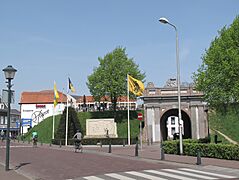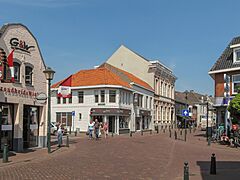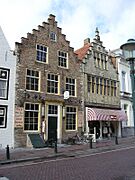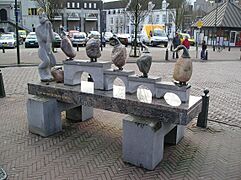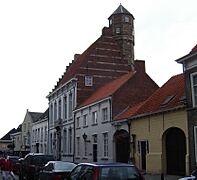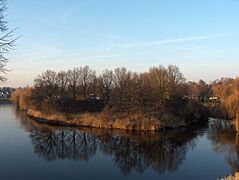Hulst facts for kids
Quick facts for kids
Hulst
|
|||
|---|---|---|---|
|
City and Municipality
|
|||
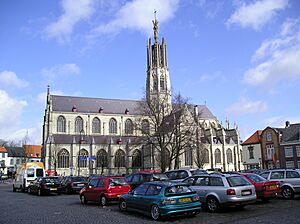
Basilica of Hulst in 2006
|
|||
|
|||
| Country | Netherlands | ||
| Province | Zeeland | ||
| Government | |||
| • Body | Municipal council | ||
| Area | |||
| • Total | 251.82 km2 (97.23 sq mi) | ||
| • Land | 201.44 km2 (77.78 sq mi) | ||
| • Water | 50.38 km2 (19.45 sq mi) | ||
| Elevation | 3 m (10 ft) | ||
| Population
(May 2014)
|
|||
| • Total | 27,370 | ||
| • Density | 136/km2 (350/sq mi) | ||
| Demonym(s) | Hulstenaar | ||
| Time zone | UTC+1 (CET) | ||
| • Summer (DST) | UTC+2 (CEST) | ||
| Postcode |
4560–4569, 4580–4589
|
||
| Area code | 0114 | ||
Hulst (Dutch pronunciation: [ɦʏlst]) is a cool city and municipality located in the southwestern part of the Netherlands. It's found in the eastern area of Zeelandic Flanders, a region in the province of Zeeland. Hulst is known for its interesting history and unique location.
Contents
A Look Back: Hulst's History
Hulst became a city way back in the 12th century. This meant it had special "city rights," which gave its people more freedom and allowed them to build walls for protection.
Battles and Sieges
Hulst has seen many battles throughout its history. In 1591, Maurice of Orange captured the city from the Spanish. But just five years later, in 1596, Archduke Albert took it back for Spain.
Later, in 1640, Dutch forces tried to capture Hulst again but were defeated by the Spanish Army. Then, in 1645, during the Eighty Years' War against Spain, Prince Frederick Henry led another important siege. The goal was to control the land along the Schelde river.
More battles happened in the 1700s. In 1702, General Menno van Coehoorn successfully defended Hulst for the Dutch. However, in 1747, the French managed to capture the city.
Building a Star Fort
In the 1600s, a special type of fort called a star fort was built around Hulst. These forts have points like a star, which made them very strong against attacks. The walls and defenses built during this time are great examples of old Dutch fortress design.
The name "Hulst" actually means "Holly" in English. Some people think the city's battlements (the top parts of the walls) looked like holly leaves. You can even see holly growing around the city's crest (its official symbol)!
Where is Hulst?
Hulst is located at 51°17′N 4°3′E / 51.283°N 4.050°E in the south of the Zeeland province. This area is in the southwest of the Netherlands. It's part of Zeelandic Flanders, a region that is only connected by land to Belgium, right on the border between the Netherlands and Belgium.
Location and Neighbors
Hulst shares its borders with several other places. To the west, it's next to Terneuzen. To the south, it borders Belgian towns like Stekene and Sint-Gillis-Waas. To the east, it's next to Beveren (also in Belgium). To the north, across the Western Scheldt river, is Reimerswaal.
Natural Wonders
One special natural area in Hulst is the Drowned Land of Saeftinghe (Verdronken land van Saeftinghe). It's a nature reserve in the northern part of the municipality. Its name comes from a famous local Saeftinghe legend about a flooded town.
Towns and Villages in Hulst
The municipality of Hulst includes several smaller towns and villages. These are:
|
|
|
Hulst's Unique Culture
Since 2018, Hulst has its own cool letter artwork. It's similar to the "I Amsterdam" sign in the capital city. This artwork moves around to different spots in the municipality. The idea behind it is clever: in the local Zeelandic dialect, people often don't pronounce the "h" sound at the beginning of words.
So, when you see the letters "n" and "h" together in white and green, you can read it as "in ulst" (meaning "in Hulst"). This clever design is part of a campaign to promote and brand the city of Hulst.
Friends Around the World
Hulst has a special friendship with another city far away. This is called "twinning." Hulst is twinned with:
Famous People from Hulst
Many interesting people have come from Hulst or had strong connections to the city. Here are a few:
- Johannes Crabbe (around 1420–1488): An important abbot (head of a monastery) and a lover of books.
- Cornelius Jansen (1510–1576): A Catholic scholar and the first Bishop of Ghent.
- Gillis Mostaert (1528–1598): A famous Flemish Renaissance painter and artist.
- Frans Mostaert (1528–1560): Another Flemish Renaissance painter, known for his landscapes.
- Cornelis de Vos (1584–1651): A Flemish painter, artist, and art dealer.
- Paul de Vos (around 1591/92–1678): A Flemish Baroque painter who specialized in animals and hunting scenes.
- Theo Middelkamp (1914–2005): A Dutch cyclist who became a world champion in 1947.
Gallery
-
A monument on the defensive rampart of Hulst
See also
 In Spanish: Hulst para niños
In Spanish: Hulst para niños





